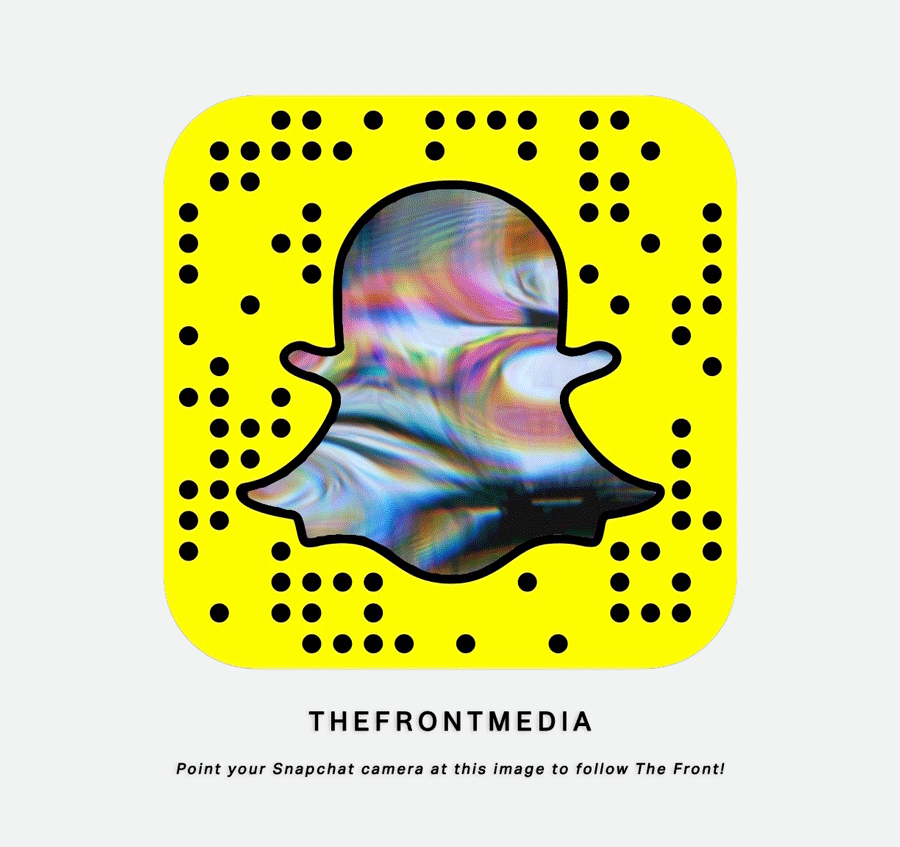THE AESTHETICS OF FEMALE RESISTANCE
To commemorate the one-year anniversary of the Women’s Marches last month, we have curated an inspiring compilation of visual protests from decades of women’s resistance movements across the United States.
A portrait of feminist activism in the United States.
By Shannan Herskovits
Last month marked the one-year anniversary of the historic 2017 Women’s Marches that took place in the U.S. and around the globe. Commencing one day after President Donald Trump’s inauguration, the marches had record-setting participation, proving that this essential democratic tradition is alive and thriving. In its honor, we have assembled a compilation of archival imagery from the Women’s Liberation Movement of the 1960s to last years marches.

NOW
Founded in 1966, at the Third National Conference of Commissions on the Status of Women, The National Organization for Women (NOW) is still one of the most significant feminist organizations in the country. Attendees of the conference vowed to form a new organization when they were prohibited from issuing a resolution that recommended the Equal Employment Opportunity Commission carry out its legal mandate to end sex discrimination in employment as outlined in Title VII of the Civil Rights Act of 1964. Members gathered in Betty Friedan’s (author of The Feminine Mystique) hotel room and got to work outlining a new methodology; it was there that Friedan, scribbled the acronym “NOW” on a paper napkin.
Still in use today, the rounded, fish-eyed NOW logo was designed by Ivy Bottini in 1969. At the time, Bottini was president of the New York chapter and openly lesbian. She held the first public forum at NOW on lesbianism titled “Is Lesbianism a Feminist Issue?”. In addition to their distinct branding, the organization created an arsenal of posters and pamphlets with empowering messages aimed at inspiring women to join the movement. 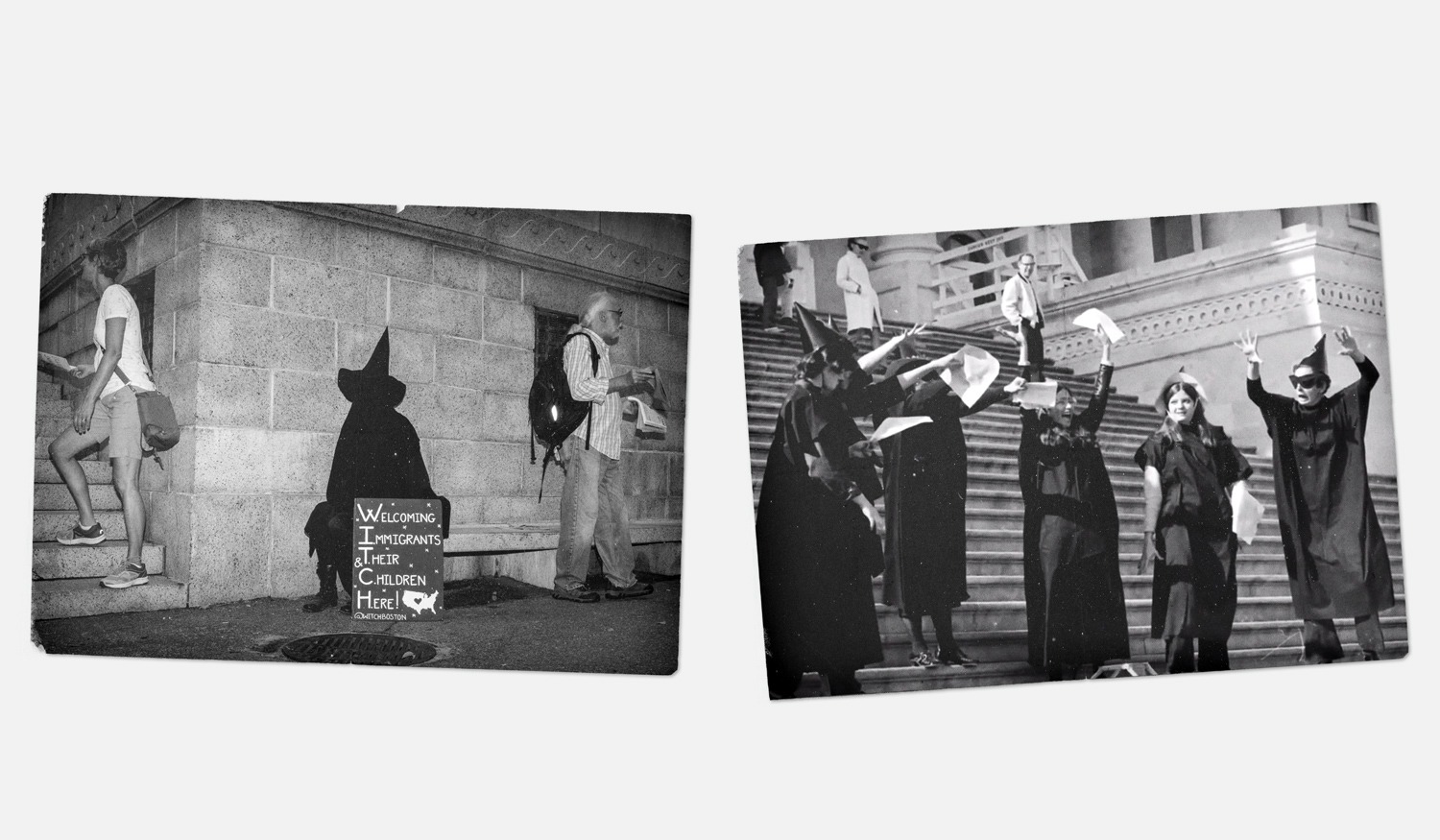
W.I.T.C.H.
The patriarchy’s worst nightmare, W.I.T.C.H. or Women’s International Terrorist Conspiracy from Hell was conceived in New York City, October 1968. Under the same moniker, several other associated groups formed around the country during the late 1960s. Devised by social feminists, members campaigned on a range of left-wing causes with the intention of conjuring wider-reaching social change. Fittingly WITCH’s first public action was executed on Halloween in 1968. Clad in pointy hats and long, flowing black capes, members paraded down Wall Street and placed a “hex” on New York’s financial district. This scheme set the stage for consequent public works in which members continued to don the iconographic witch attire.
Resurrected by three women of the Chicago chapter in 2015, the activist coven has been reinvigorated by the current political climate. The next generation of WITCH has protested issues such as the lack of affordable housing, abortion rights and the Trump administration’s condonation of racism and sexism.

REDSTOCKINGS
Founded in January 1969 by Ellen Willis and Shulamith Firestone in New York City, Redstockings of the Women’s Liberation Movement was a radical group associated with second-wave feminism. The name Redstockings is a portmanteau of the term “bluestocking” (which was used to disparage feminist intellectuals of earlier centuries) and the color red (for its association with the revolutionary left). Redstockings had a vital role in the spread of women’s liberation theory and popularizing slogans such as; the personal is political, sisterhood is powerful, and the politics of housework.
The bold, crimson Redstockings stamp was designed in 1969 by Shulamith Firestone and featured the Old English type style which became its signature logo. The stamp was originally created for answering the massive influx of letters addressed to the organization from women around the country. The emblem subsequently became a prominent symbol associated with women’s lib.
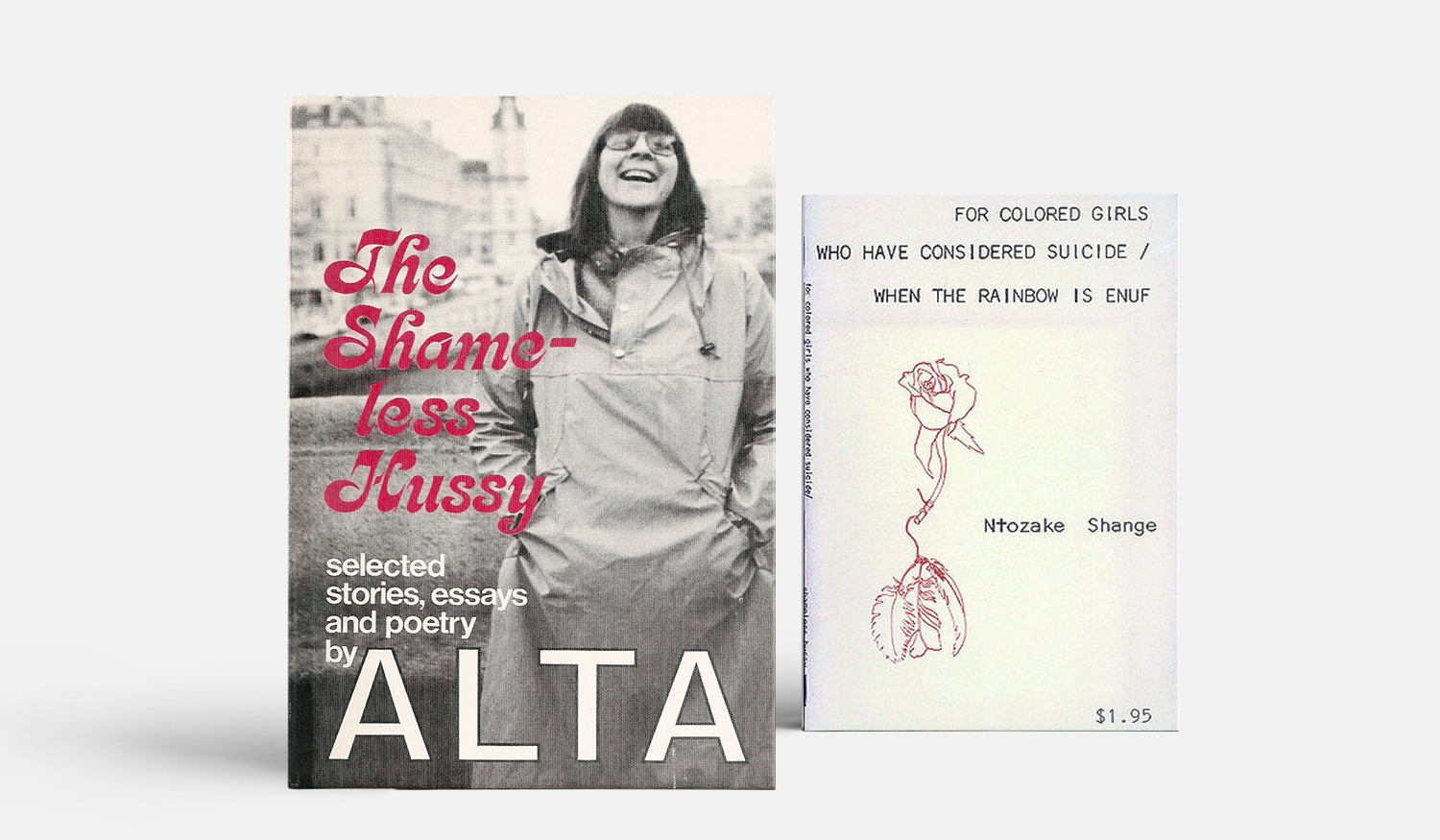
SHAMELESS HUSSY PRESS
Conceived by Alta Gerrey in Oakland in 1969, Shameless Hussy Press was the first feminist press in the United States. “At that time, 94% of the books printed in the U.S. were written by men. I called the press Shameless Hussy because my mother used that term for women she didn’t approve of, and no one approved of what I was doing.”—Alta
Alta ran the independent publisher for 20 years amidst death threats and persistent sexism. In spite of these hardships, Shameless Hussy was a seminal contributor to the history of women’s literature. The press published over fifty titles including the first books by Pat Parker, Mitsuye Yamada, Ntozake Shange, and Susan Griffin. These four women would later become internationally recognized feminist writers.

CHICAGO WOMEN’S GRAPHICS COLLECTIVE
Organized in 1969, The Chicago Women’s Graphics Collective was entrusted with creating posters for the growing women’s liberation movement. To set the collective apart from the prevailing male-dominated Western art culture, the founders ensured their new feminist art would be created through a unified process. To guarantee unanimity, each poster was generated by a committee of 2 to 4 women and led by an artist/designer.
The collective utilized silkscreening to create brilliantly colored prints in large quantities on a low budget. Later the group used offset printing to produce their more popular posters. Thousands of these bespoke signs sold internationally until the dissolution of the Graphics Collective in 1983.

IT AIN’T ME BABE COMIX
It Ain’t Me Babe Comix was the first one-shot underground comic book entirely produced by women. Fed-up with the prevailing boy’s club attitude of the underground comix scene, female cartoonists Trina Robbins, Barbara “Willy” Mendes, and “Hurricane” Nancy Kalish set out to turn the page on the male-monopolized genre.
Published by Last Gasp, the 36-page comic made its debut in July 1970. The first cover featured cartoon characters Olive Oyl, Little Lulu, Wonder Woman, Sheena, Queen of the Jungle, Mary Marvel and Elsie the Cow with their fists raised in revolt and the words “Women’s Liberation” inscribed above. Other editions of the comic featured fictional female protagonists such as the Bride of Frankenstein brandished in feminist symbology, arousing looks of dismay on the faces of surrounding male characters.

LAVENDER MENACE
The phrase “Lavender Menace” was first used in 1969 by the president of NOW, Betty Friedan, to describe the threat that she believed associations with lesbianism posed to the emerging women’s movement. Friedan and other heterosexual feminists were concerned that lesbianism would give critics of the women’s movement an easy scapegoat to denounce their behavior as “man-hating.” On May 1, 1970, in New York City at the Second Congress to Unite Women, a group of lesbian feminists came together to protest the exclusion of lesbians and lesbian issues from the movement. That day, over 300 women interrupted planned programming while proudly sporting t-shirts with the label “Lavender Menace” stamped across their chests. The Menaces took the stage and began to read their manifesto, “The Woman-Identified Woman” which preached that “Women need to identify with women, not with men.” At the end of the reading activist, Rita Mae Brown yelled a rallying cry, “Who wants to join us?” Several women replied, “I do, I do.”
The protest termed the “Lavender Menace” zap is considered a turning point to second-wave feminism. Many of the zap organizers went on to create the “Radicalesbians” organization. In September 1971, delegates at the following NOW conference adopted a resolution recognizing lesbianism and lesbian rights as “a legitimate concern for feminism.”
THE YOUNG LORDS PARTY
The Young Lords began in 1960 as a Puerto Rican turf gang in the Lincoln Park neighborhood of Chicago. In 1968 president Jose Cha Cha Jimenez turned the party into a national civil and human rights operation that would eventually span over 30 cities including three branches in New York City. The mobilization of the association in the latter was integral to the movement because, at the time, NYC was the port of entry for more than 90% of Puerto Rican immigrants. The Young Lords created community initiatives similar to those of the Black Panthers, including free health clinics, clothing drives, and history classes.
The female leadership in New York pushed the Young Lords to fight for women’s rights and condemn the United States government’s practice of forced sterilization in Puerto Rico. In Chicago, it was a sub-group within the Young Lords led by Hilda Ignatin, Judy Cordero and Angela Adorno called (M.A.O.) Mothers And Others that organized around women’s rights and saw to the education of male members and the community at large. In addition, to their community outreach programs, the party disseminated posters and leaflets featuring fearless political art calling out long-standing injustices committed against the Puerto Rican population. In line with other civil rights defenders, members also frequently wore berets decked with political pins as an element of party affiliation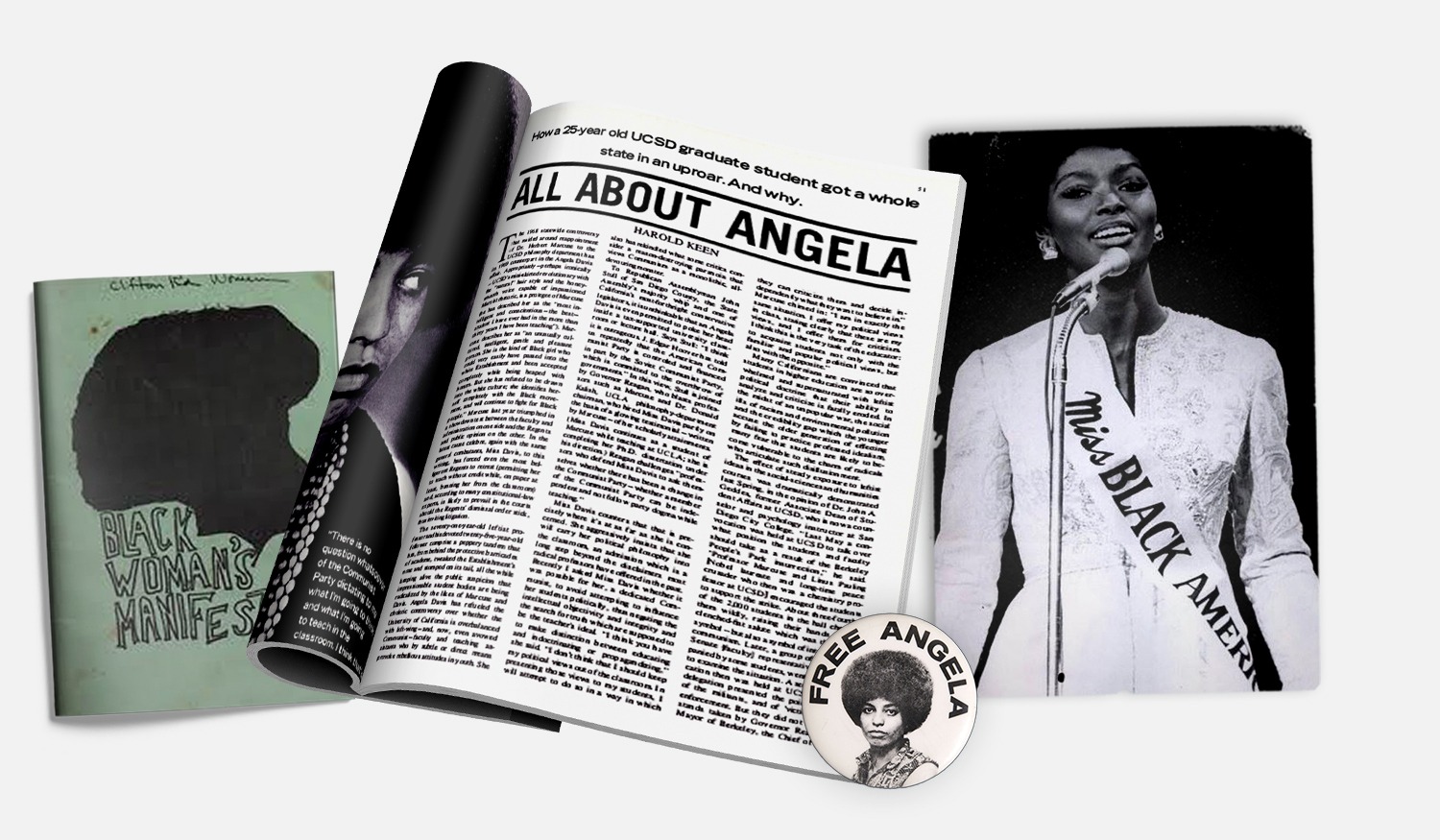
BLACK WOMEN’S LIBERATION
Black feminism became popular in the 1960s after the male-dominated Civil Rights Movement and the Feminist Movement largely ignored issues facing women of color. Among the theories that evolved out of the Black Women’s Liberation is Alice Walker’s “Womanism,” and historical revisionism with an increased focus on black women. From this point, Angela Davis, bell hooks, Kimberlé Williams Crenshaw, and Patricia Hill Collins emerged as the leading academics on black feminism.
Black feminism embraced the art and culture of the African-American tradition and black ancestry as popularized by the Black Power Movement and The Black Arts Movement (BAM). Black feminism also challenged the status quo of Eurocentric beauty. On August 17, 1968, the first Miss Black America Pageant was held at the Ritz-Carlton in Atlantic City with support from Phillip H. Savage, Tri-State Director of the NAACP. The pageant received nationwide press coverage as a protest against the Miss America Pageant, an event that Savage and other NAACP leaders had sharply criticized for the exclusion of black women contestants.
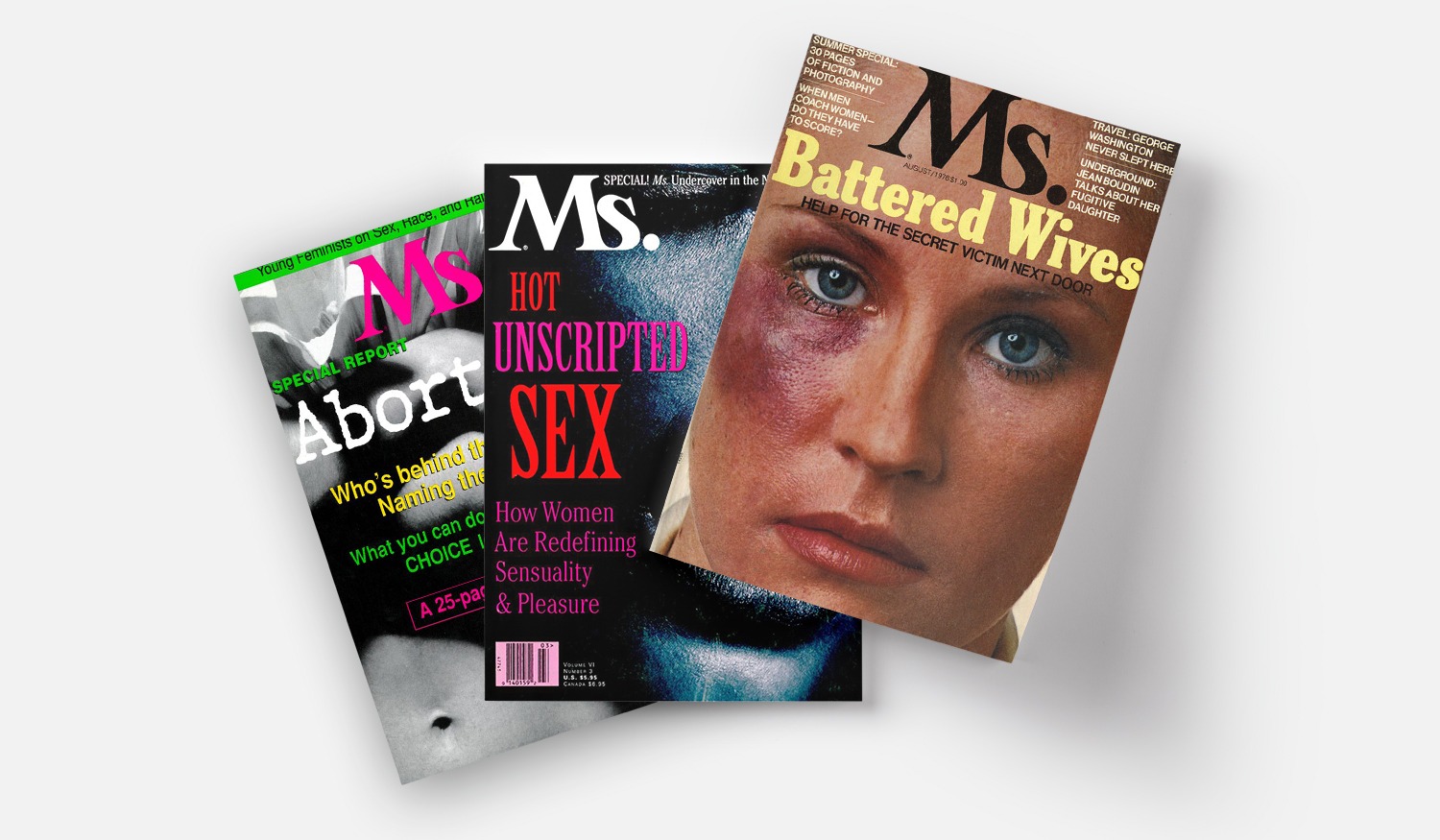
MS MAGAZINE
Co-founded by second-wave feminists and activists Gloria Steinem and Dorothy Pitman Hughes, Ms. Magazine first appeared in 1971 as an insert in New York Magazine. The first stand-alone issue cropped up on newsstands in January 1972. The publication was created to fill the void where the mainstream media had failed to represent the voices of women by women. During its heyday in the 1970s, Ms. placed women’s issues quite literally at the forefront featuring evocative imagery portraying highly debated topics like abortion and female sexuality on the cover.
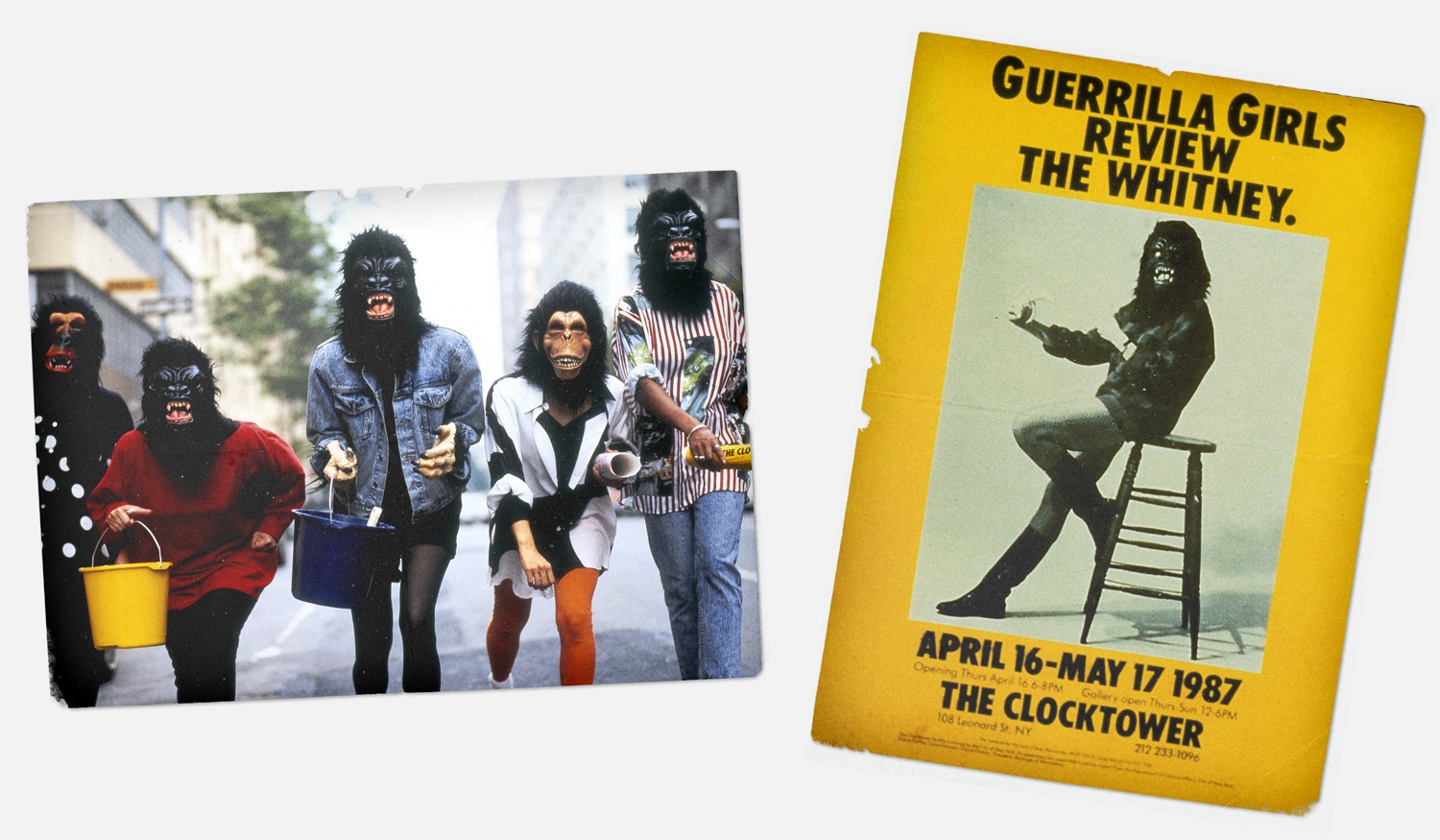
GUERILLA GIRLS
Formed in New York city in 1985, the Guerrilla Girls is an anonymous group of feminist artists devoted to fighting sexism and racism within the art world. To remain incognito, members wear gorilla masks and identify by pseudonyms that reference deceased female artists. For members, anonymity allows emphasis to be placed on the issues at hand rather than their personal identities.
Throughout their existence, the Guerrilla Girls have gained the most attention for their eye-catching protest art. Their posters, books, billboards and guerilla-style performances have shed light on the pervasive sexist attitudes dominating the art world. For example, in 1985 the Guerilla Girls printed a poster illustrating the stark salary gap between men and women in the arts versus the United States average, stating “Women in America earn only 2/3 of what men do. Women artists earn only 1/3 of what men do.” Early on these posters often revealed the chauvinist tendencies of specific institutions and artists.
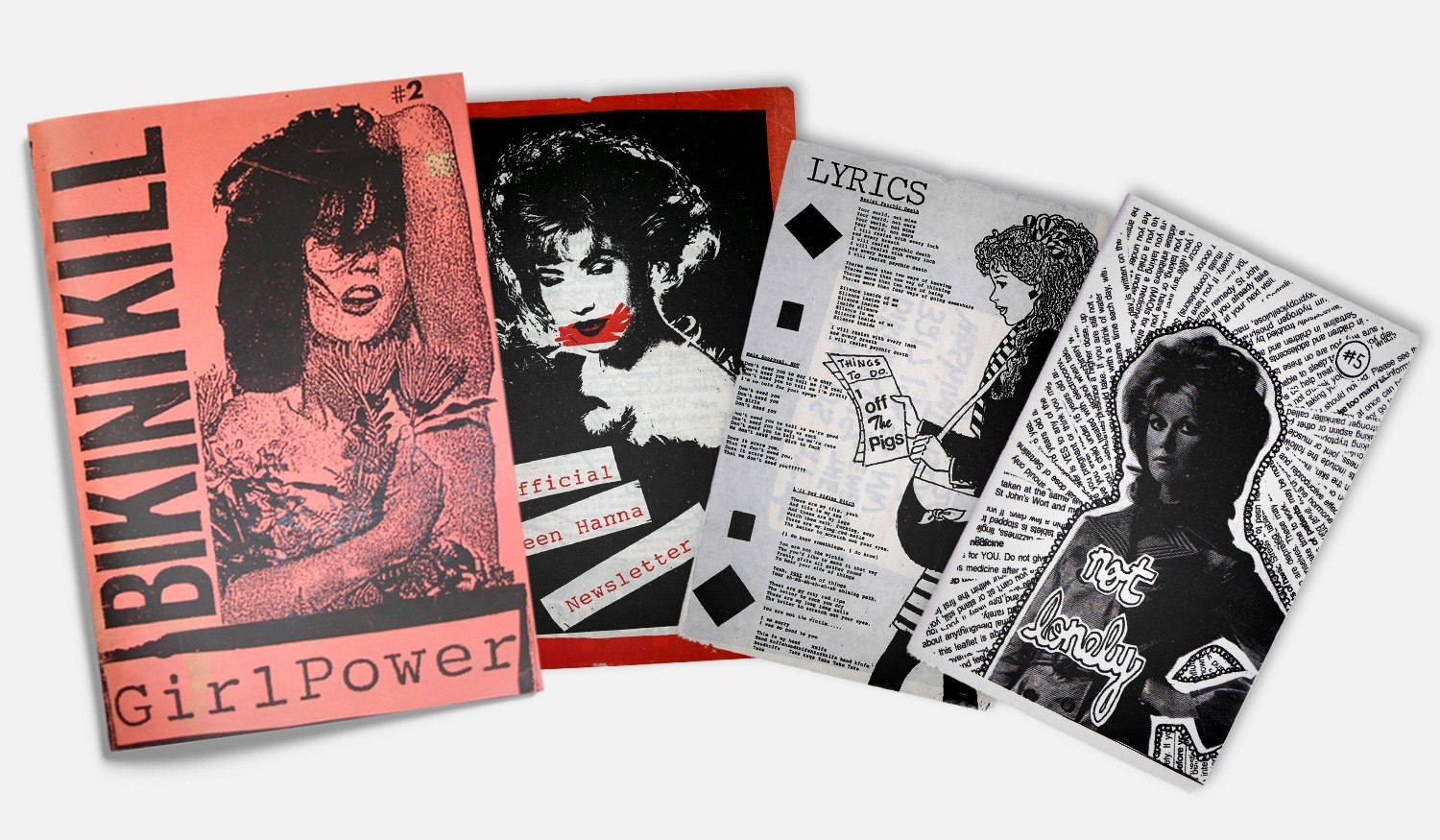
RIOT GRRRL
Riot Grrrl started as an underground feminist punk movement in the early 1990s in Washington state (notably Olympia and the greater Pacific Northwest). Riot Grrrl is one part third-wave feminism and one part music genre, combining punk ethos and music with activism.
Musicians in the movement often addressed issues such as rape, domestic abuse, sexuality, racism, patriarchy, and female empowerment. Primary bands affiliated with Riot Grrrl include Bikini Kill, Bratmobile, Heavens to Betsy, Excuse 17, Huggy Bear, Skinned Teen, Emily’s Sassy Lime and Sleater-Kinney, as well as queercore groups like Team Dresch and The Third Sex. These bands helped color the movement and spread the political ideologies at its core. In addition to a music scene, Riot Grrrl subculture involved a DIY ethic that championed the creation of homemade zines as works of political and personal expression.
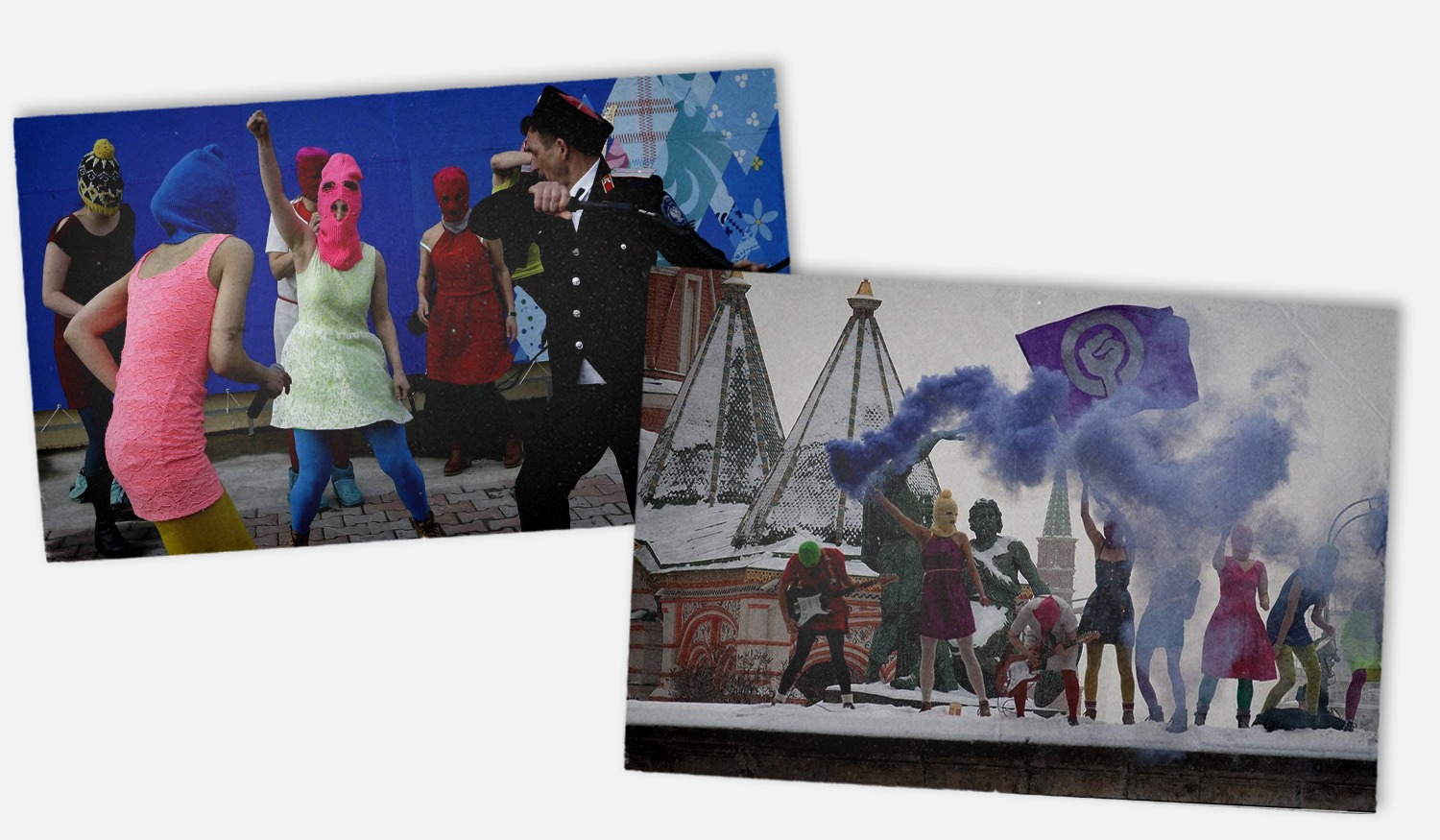
PUSSY RIOT
Pussy Riot is a feminist punk rock protest group founded in Moscow, Russia in 2011. Sheathed in brightly colored dresses and tights with matching balaclavas to conceal their identities, the group engaged in unauthorized guerrilla performances throughout the Russian capital, causing an outcry from religious conservatives. The collective’s lyrical themes include feminism, LGBT rights, and opposition to Russian President Vladimir Putin, whom the group considers to be a dictator.
Pussy Riot garnered global attention when five members staged a performance of the song “Punk Prayer” inside Moscow’s Cathedral of Christ the Savior on February 12th, 2012. The women said their protest was directed at the Orthodox Church leaders’ support for Putin during his election campaign. The incident lead to the arrest without bail of three members Nadya Tolokno, Maria Alyokhina, and Yekaterina Samutsevich. On August 17, 2012, the three women were convicted of “hooliganism motivated by religious hatred,” and each sentenced to two years imprisonment.
Although the group’s initial actions took place in Russia, the band’s popularity spread to the states and internationally with followers staging protests urging for the women’s acquittal. After their discharge from prison, members Nadya Tolokno and Maria Alyokhina released Pussy Riot’s first English language song in 2015 titled, “I Can’t Breath” dedicated to Eric Garner. Member Nadya Tolokno has continued her Pussy Riot advocacy in the U.S. releasing an album and several music videos criticizing the trump administration including the song and video “Pussy Grabs Back.” 
SLUT WALK
On January 24, 2011, Toronto Police Constable Michael Sanguinetti and another officer spoke on crime prevention, addressing the issue of campus rape at a York University safety forum. During the talk, Sanguinetti stated: “I’ve been told I’m not supposed to say this – however, women should avoid dressing like sluts in order not to be victimized.” Outraged by the statement organizers created the SlutWalk calling for an end to rape culture, including victim blaming and the slut-shaming of sexual assault victims.
SlutWalk’s first demonstration was in Toronto, Ontario, on April 3, 2011, with over 3,000 people in attendance. The protests have since commenced globally, with women proudly flaunting “slutty” attire. Celebrity Amber Rose has been an ardent supporter of the march, creating the Amber Rose SlutWalk Festival in Los Angeles which includes speakers, workshops, free breast cancer exams, and HIV testing.

BLACK YOUTH PROJECT 100
On August 19th, 2017 protesters from The Black Youth Project 100 gathered in Central Park at Fifth Avenue and 103rd Street to demand the removal of a bronze statue dedicated to 19th-century doctor James Marion Sims. Considered to be “the father of modern gynecology,” Sims conducted excruciating experiments on enslaved African American women without anesthesia— operating under the racist notion that black people did not feel pain.
In their protest, women from the project dressed in hospital gowns splattered with brightly colored imitation blood on their wombs. The attire symbolized the dozens of painful surgeries and resulting ailments such as blood poisoning that Sim’s patients were forced to endure.

WOMEN’S MARCH ON WASHINGTON
A direct response to the election of president Donald J. Trump, the Women’s March was a worldwide event that took place one day after his inauguration on January 21st, 2017. The majority of the rallies centered in protest around Trump’s offensive and sexist characterizations of women. Between 3,267,134 and 5,246,670 people participated in the Women’s March in the United States, making it the largest single-day protest in U.S. history—with worldwide participation estimated at over five million.
A crowning symbol of the protests, the Pussyhat, was created by Krista Suh and Jayna Zweiman of the Pussyhat Project. Millions of the pink cat eared knit beanies were worn at marches nationwide. Signs at the rallies subverted the disparaging words uttered by Trump into catchphrases of resistance including a play on Trump’s infamous ‘grab them by the pussy” with “pussy grabs back,” while his characterization of Hillary Clinton as a “nasty woman” became a unifying slogan plastered on t-shirts and posters.
